Type of Brushes for Acrylic Painting: A Guide for Beginners
You’ve wanted to paint for a while, and you got all the supplies but do you still wonder which types of brushes to use for acrylic paint?
In this guide, you’ll learn what types of brushes for acrylic painting you need as a beginner and some basic info on these tools. This info can help you choose the brushes for your needs.
What to have in mind before buying acrylic paint brushes?
As someone who’s starting art journaling with acrylic paints, there are a few things you’ll have to keep in mind.
The 7 main types of brushes for acrylic paint (discussed below) are all for different purposes. Thus, it matters what you’ll use it for, defining the shape and size you should get.
Simultaneously, the handle of a paint brush also determines your final choice. It depends on the comfort level to decide whether you want a narrower or broader handle.
While considering all this, you must also be aware of the money you are willing to spend on these brushes. Of course, the higher the quality, the higher the price. You’ll be the judge of what you can spend on them.
Types of brushes for acrylic painting
Following are the 7 main types of acrylic paint brushes (although they are not limited to acrylic paint only):
Round
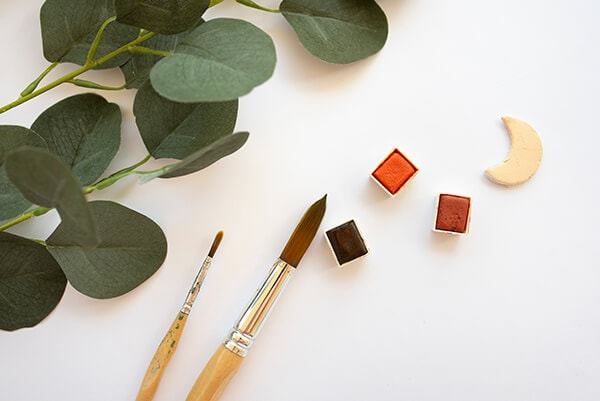
I use round brushes mainly for watercolor since they’re soft and adjustable. This means you can use them for larger strokes and detail work. They keep water and watercolor well so you have enough to paint with only one take.
Also, you can mix watercolors well with them and apply the paint to paper for different techniques, especially the wet-on-wet technique.
I don’t like using them with acrylic paint because they’re too soft. However, if you dilute acrylics with water, this brush can be a great option for painting.
This is just my experience, you go ahead and experiment. That’s the best way to learn new things.
Filbert
A filbert brush has an oval tip which makes it a great one to work with acrylics or oil paint. It doesn’t leave strokes with clean edges so it can be used for blending.
Flat
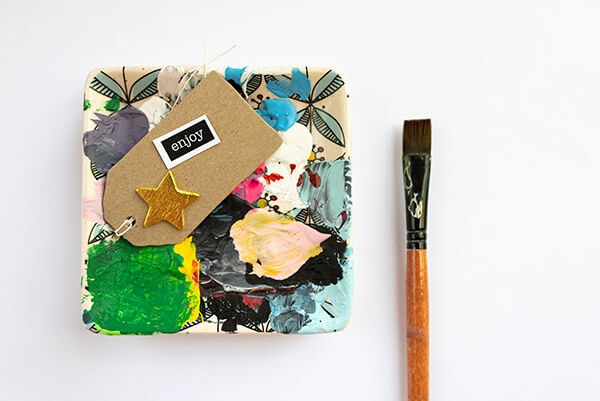
Flat brushes are excellent for acrylic paint but also for watercolor. I mostly use them for larger surfaces for both, acrylics and watercolors.
Unlike filbert brushes they do leave clean-cut edges, but, as I said, this is great for larger areas, especially if you want to paint the whole background quickly.
They can also take a lot of paint at once, so you don’t have to reload with paint from your palette for a new stroke each time. This means you can make longer strokes.
Bright
These are also flat brushes but they have shorter bristles. So, you can use them for shorter strokes like single marks or thick lines.
Since the bristles are shorter, you can have more control of your strokes. However, they don’t hold as much paint as the longer flat brushes.
Rigger
These brushes have longer hair and are thinner. So, they’re commonly used for lines (straight or curvy) and details.
Fan
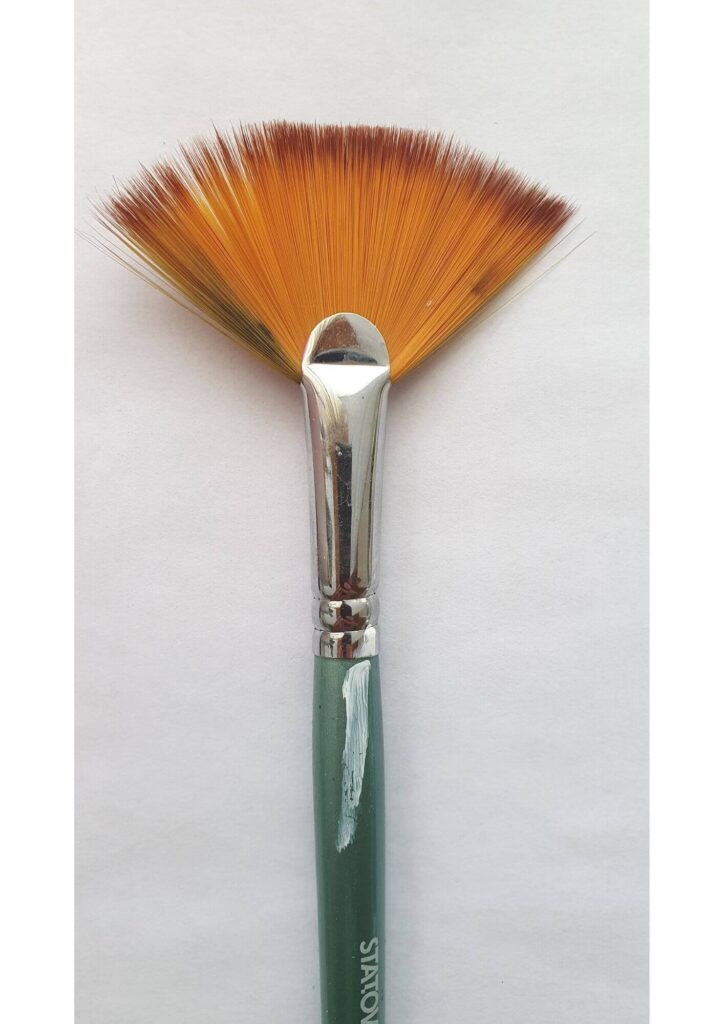
This one is called a fun brush because of its shape. It really looks like a fan – the bristles are spread out and the tip forms a semi-circle.
You can use these brushes for painting grass, hair, branches, etc. However, it takes a bit of practice until you get used to it since it can create repetitive marks.
You can’t really use it for blending since the bristles are too soft and shaped like a fan.
But it’s great for neat effects so you’ll have some fun experimenting with it when using acrylics or watercolor.
Angled
Angled paint brushes are cut at the top at an angle. This makes them perfect for painting straight lines, painting in corners, or creating thicker, straight lines.
Mop
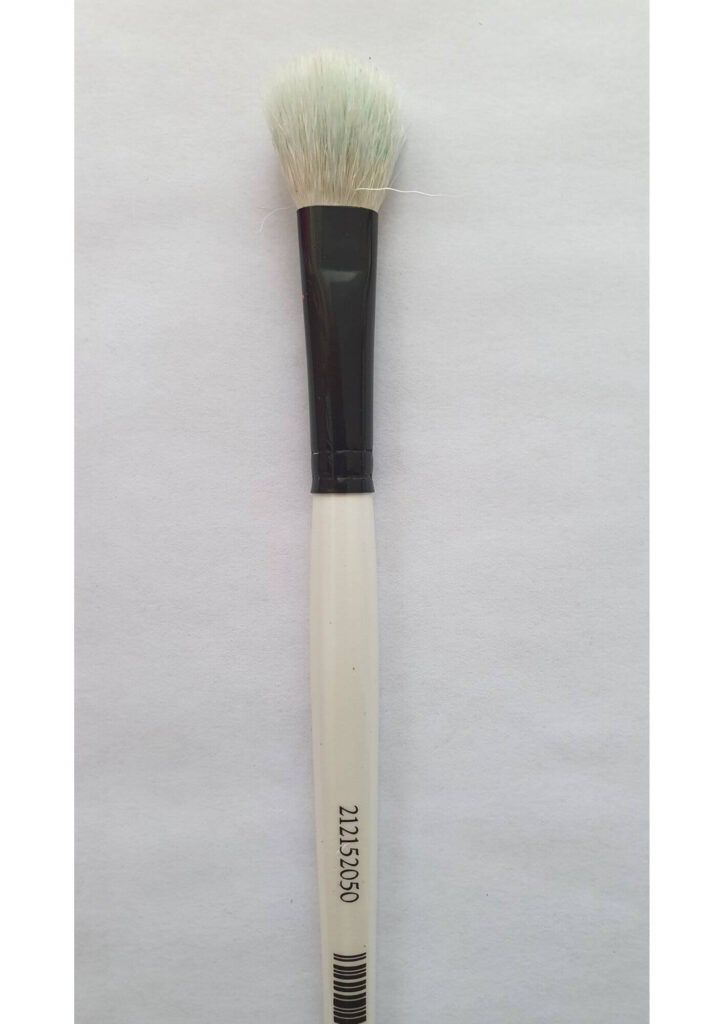
A mop brush looks like a tiny mop.
You can use them with watercolor for larger areas, not for details (because of their shape).
They can also be used for blending wet paint, but if it’s too soft and you use acrylics without water, you’ll have trouble blending. Try diluting acrylics with water and then use this brush to spread the paint or blend.
SHAPES OF ACRYLIC PAINT BRUSHES
The name of the brushes mentioned above easily defines their shape as well. They are:
- flat
- round
- angled
- fanned
- mop
SIZE OF ACRYLIC BRUSHES
Just as you saw how diverse the range of acrylic paint brushes is, you must know it is the same with the sizes they come in. The size you choose depends on the scale of your work.
There are many sizes of acrylic brushes, and I sometimes like to put them in three categories to make my life easier: small, mid-size, and large.
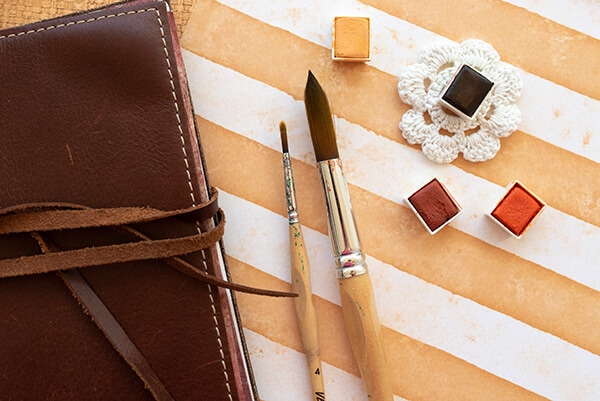
I use the small size for details like dots, line work, when I paint eyes, etc. (size 0 to 4)
The big-sized brush is used for larger areas like backgrounds, big shapes, etc. (size 18 to 20+)
The mid-size acrylic brushes are somewhere in between and I use them most of the time. They’re not too big or too small. (size 10 to 18)
The way you can determine what your small, mid, and large sizes are, you should look at a variety of them and see which ones fit perfectly in your hand. There’s no strict rule, you decide what you like using. Plus, add the purpose factor: what you’re going to use it for.
However, the size numbers on the brushes help you identify the size you need. For example, a size 20 is a really large brush, but not the largest.
There’s no standard in numbering paintbrush sizes, but I’ve usually come across sizes ranging from 0 to 30.
ACRYLIC BRUSHES BRISTLES
Bristles on acrylic paint brushes can be:
- natural
- synthetic
- stiff
- soft
The price of each of these will differ because of their rarity and value. For example, acrylic paint brushes with natural bristles will be heavy on the pocket, given their quality and longevity.
Natural acrylic paint brushes
When I was starting out and learning about brushes with natural hair, that sounded really fancy to me. Then I found out that natural hair isn’t that good for acrylics but is mostly used for oil painting.
Natural hair is sensitive, you can’t leave it in water for too long because it hurts the hair. Also, acrylic paint is harsh for natural hair.
If you want to use them with acrylic paint, just remember to take proper care of them. Don’t leave them in water but clean them properly every time.
Synthetic brushes for acrylic painting
Synthetic brushes are more durable and not that expensive, so you can use them more freely with acrylic paint.
They are easier to clean and paint with. You can leave them in the water longer and the hair won’t deteriorate.
Taking all this into account, they’re overall more durable. And since they’re cheaper, this is a big plus for them.
Stiff acrylic paint brushes
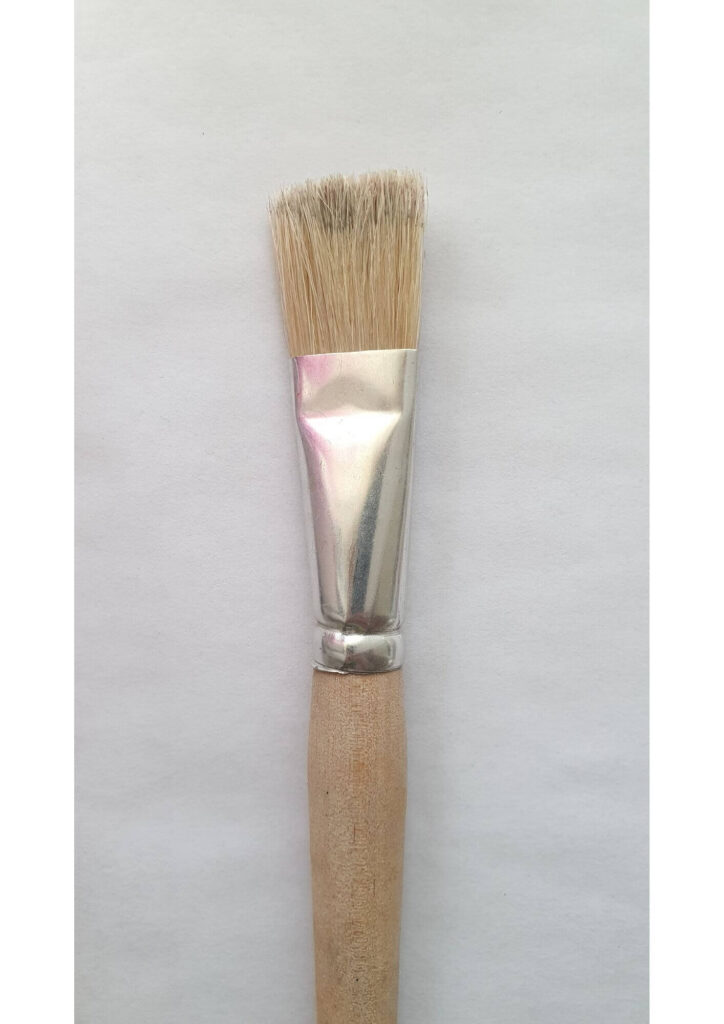
The name says it all. They’re stiff. This means they can be used for heavy-body acrylics and will leave visible strokes when you paint. This is great for creating texture.
Soft acrylic paint brushes
As opposed to brushes with stiff hair, these brushes have softer hair and can be used for spreading paint easily. Also, they tend to adjust their shape since they’re soft, unlike stiff brushes that maintain their shape while painting.
BEST beginner’s brushes for ACRYLIC PAINTing
Choosing the best acrylic brush for beginners isn’t a difficult task. All you need is to find the one you can easily navigate your hand around with.
For art journaling, you might want to go for the smaller or the mid-sized brushes, given the proportions of your page and the details you wish to add. The ideal size for it would be 4, 6, 8, or 20.
While being at it, you’ll also face the conundrum of choosing the handle size. I suggest you pick the ones with smaller handles, given you’ll be working on a journal and adding minute details. Longer handles are for painting from a distance on bigger scales.
The length, shape, and type of bristles will depend on your scale of work, the desire for the kind of effect you want to give off, and your expertise in managing the brushes.
I recommend you go for brushes with short rounds or flat and soft synthetic bristles, given that you’re just a beginner.
Since you’re in your experimentation phase, you can’t afford to waste quality and expensive acrylic paint brushes in case you mishandle them. In such a scenario, you must keep your bases covered.
To do this, you can pick a cheaper brand that doesn’t let you feel guilty when you’re going all out while testing them out in your journal.
As you may have deciphered by now, your purpose is what directs you to your required type, size, length, and bristles of acrylic paint brushes.
BEST ACRYLIC BRUSHES FOR BACKGROUNDS
For art journal backgrounds, I recommend going for big and flat acrylic paint brushes. They’ll cover a lot of areas at once and save you time.
You can play with strokes and different directions to achieve a bit of texture.
Then, you can also use smaller brushes to add patterns or marks to your backgrounds. Again, I suggest flat or filbert brushes for this.
You can use the fan brush for sprinkling and adding more interest with white or black paint.
Using a stiff brush can add interesting texture to your backgrounds so you can experiment with that, too.
BEST ACRYLIC paint BRUSHES FOR DETAILS
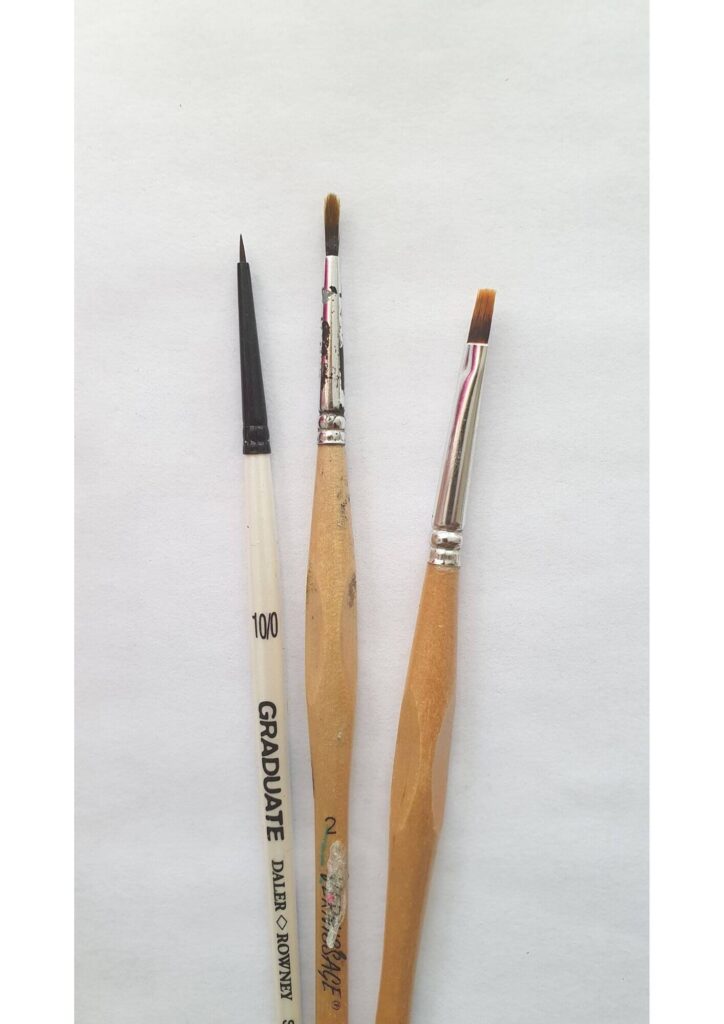
Of course, the smaller the size of the brush, the better the details. In such a situation, the best acrylic paint brush will be the one with smaller bristles and a handle.
These ensure you make fine lines cleanly and do not paint outside of them.
You can try detailed brushes in various sizes. If you think you have a small, detail brush, I assure you there’s even a smaller one out there.
These detail brushes are also great for lettering. I enjoy using them to write a few words with watered-down acrylic paint.
BEST ACRYLIC BRUSHES FOR PAINTING (WHIMSICAL) FACES
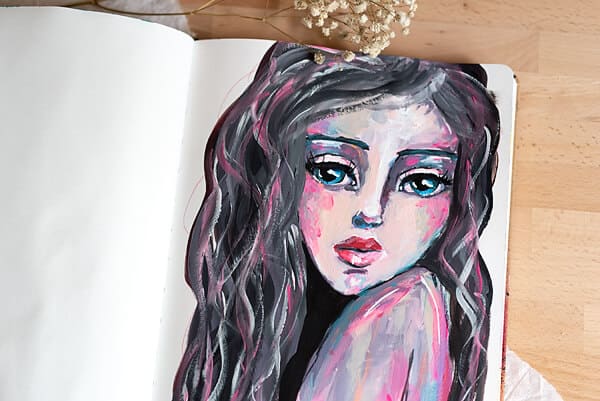
You could get a medium flat acrylic paint brush for painting larger areas, a small and round for blending inside the face, and a detail brush for small things, such as details in the eye, etc.
You can still get frustrated when trying to paint faces and the brush just doesn’t work. It doesn’t blend nicely, or the bristles act all funky. This again comes down to the quality and price. Not just the brushes, but the acrylic paint also.
Even now, after years of painting, I still sometimes struggle with that. So, be prepared that you need to invest time into practicing with your brush. A lot.
I just want to remind you that learning how to use acrylic paint brushes is a process, and you need to be patient and practice.
acrylic brushes care
Caring for your acrylic paintbrushes is also an important task.
You must always store paintbrushes with their bristles upright in any jar or cup in your house. You could also place them flat on a tray. Never keep them upside down. It will ruin the bristles.
You should take off all the residual paint after you’re done working to avoid it from spoiling any of your future masterpieces.
To do this, first, use a paper towel or a rag to blot out excess paint from the brush (gently, please).
Next, thoroughly rinse them in lukewarm water, and wash and gently lather them with a light soap (optional, you can only use water and your fingers).
And finally, rinse them with clean water. Reshape the tip of the brushes with your fingers and let them dry.
As I already mentioned above, synthetic brushes are long-lasting and can withstand the harsh nature of your work.
However, brushes with natural bristles will need you to take extra care of them.
Paint brush holders and organizers
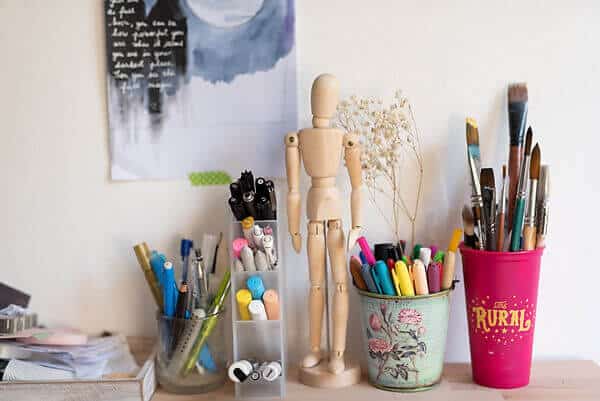
You don’t need to purchase any special type of brush holder or organizer to manage your acrylic paint brushes. Any cup, tray, vase, and basically anything that can hold the brushes will suffice.
You will certainly find any such thing at your home only.
But if you do want to invest in organizers for brushes, here are a few examples you might like:
Foldable acrylic brush organizers
If you’d like to take your brushes with you and paint outside, these foldable holders are amazing. They keep your brushes safe and can fit into any bag.
Also, this bamboo foldable holder made for ten brushes is so cute and it looks kind of artsy.
Cups & vases
These are the most common holders for brushes. If you don’t have something at home, you can always buy any kind of glass, vase, or cup.
Recently, I loved this bamboo holder.
Paint brush holders while working with them
I love these holders, they’re a great solution for keeping your brushes while you use them but need to leave them for a minute or two.
They come in different materials, some are really fancy and cute-looking. Here are a few examples you might like:
Paint brush holder with 5 slots
I have this brush holder by Faber-Castell. It can hold around 5 brushes at a time and it has a water container, too.
acrylic PAINTBRUSH SETS
Buying a paintbrush set seems rational, given how every type of brush is available in it. You do not have to run around the market for a certain one separately. These sets come in various sizes, types, and quality, and with its vast market, you will definitely find the one you need.
The best part is, paint brushes are cheaper in sets than when purchased individually.
On the other hand, buying complete paint brush sets might seem redundant to a few people if they only require a few types of brushes in them. The price might seem enticing, but the rest, the ones not needed, go to waste.
Best affordable acrylic paint brushes on Amazon
Following are a few affordable paint brush sets available on Amazon that you might want to check out.
Princeton Acrylic Paint Brush Set
20 Pcs Paint Brushes for Acrylic Painting
FAQs about acrylic paint brushes
1. Can you use make-up brushes instead of acrylic brushes?
Makeup brushes can be used instead of acrylic paint brushes; however, keep in mind that you can’t use them for make-up anymore.
2. Can I use watercolor brushes for acrylic paint?
It’s not recommended that you do this because watercolor and acrylics are different media. Their density and subsequent stroking differ hence the need for a unique set of brushes for both.
3. What other tools can I use with acrylic paint?
A few other tools that you can use with acrylic paint are a palette knife, sponges, and brayer. These work amazingly for unique strokes and effects.
types of brushes for ACRYLIC PAINTing RECAP
In essence, the rather expansive range of acrylic paint brushes has made life easier for newbies. You can get affordable, student-grade brushes and still make wonderful art and enjoy painting techniques.
Before finalizing a purchase of acrylic paint brushes, remember your purpose, be mindful of your price range, and read reviews.
Now that you know what brushes to use, start making those beautiful pages with this FREE Art Journal Starter Course
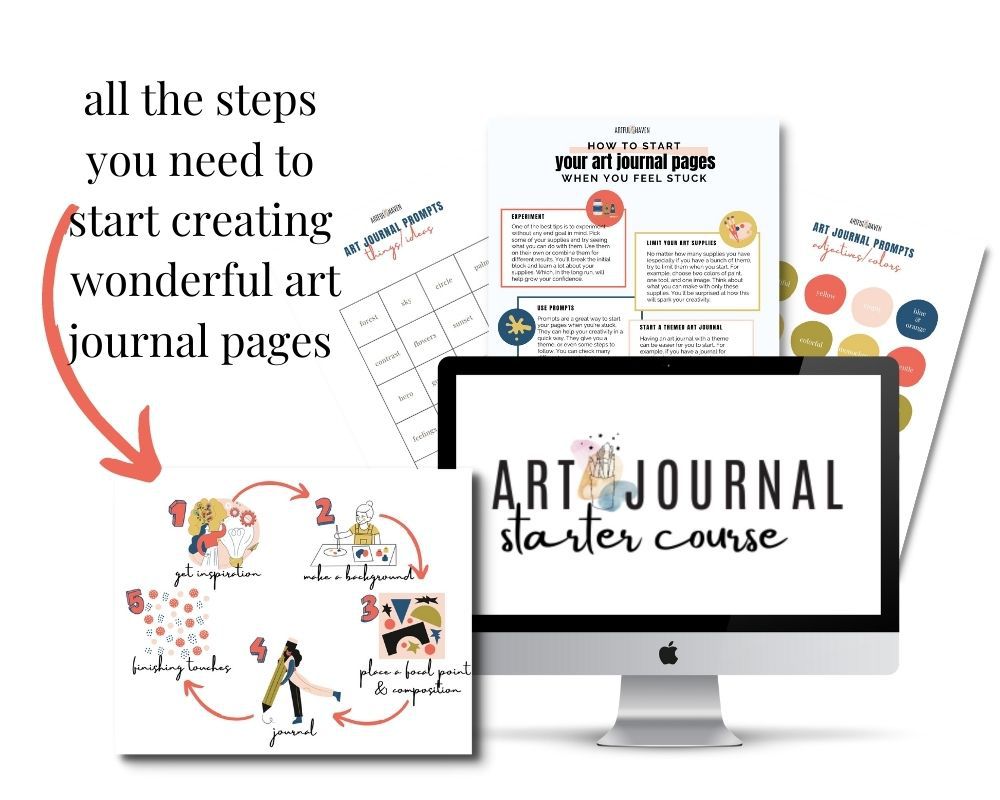
Related articles on acrylic paintbrushes and painting
What Is Acrylic Paint? – Everything You Need To Know To Start Painting With Confidence
13 Ways to Paint Without A Brush in Your Art Journal
Top 11 Art Tools And Materials for Drawing And Painting in Your Art Journal
